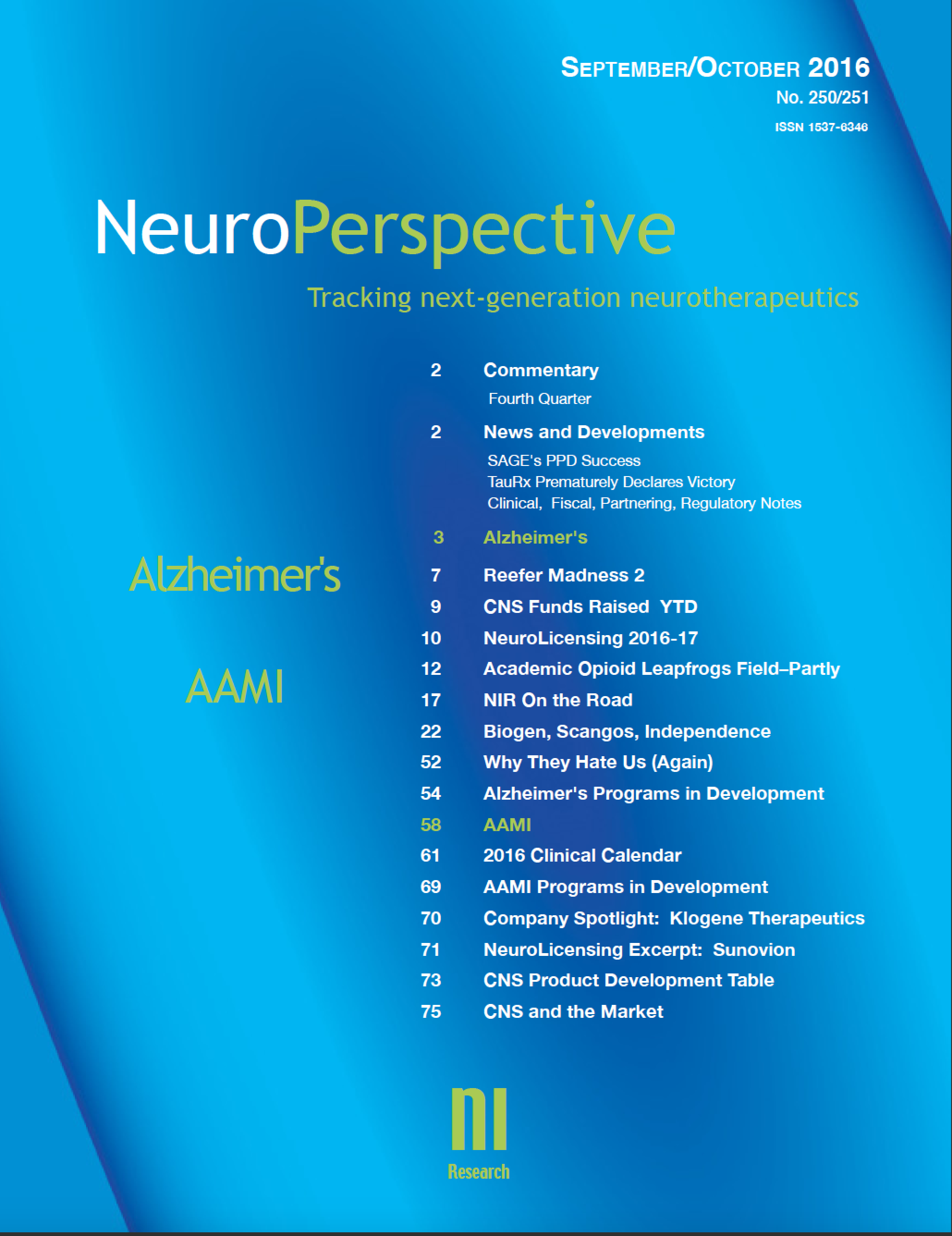The Summer 2024 issue of NeuroPerspective has been released. It features three comprehensive therapeutic area reviews: Psychedelics, Epilepsy, and Frontotemporal Dementia.
1) There is no area of neurotherapeutics that combines promise and controversy in the same measure as Psychedelics, a novel class undergoing rapid developmental transformation. Recently, the most salient drama has involved the utilization of MDMA for PTSD. MAPS had successfully completed its second PhIII trial of MDMA in PTSD, and then spawned Lykos Therapeutics as its for-profit component. But Lykos recently had all the wrong headlines generated by its awkward encounter with the FDA’s ADCOM, a Committee which lost track of its priorities and the Agency’s scope of activity, neither of which include regulating psychotherapy, an integral component of the Lykos treatment package. The ADCOM bogged itself down with the thorny issues of functional unblinding and abuse risk, the Agency has little to offer about the former, but ample ability to reduce the latter, via a stringent REMS protocol. We suspect that the FDA’s PDUFA date of 8/11/24 may be extended, as the Agency seeks to find a resolution that would address the concerns of the ADCOM without sacrificing the patients, and the SPA in place since 2017. But in the meantime, the psychedelics field has taken a hit, the fear raised that the FDA will place unreasonable obstacles in their path. This is unfortunate, because tangible clinical progress is being made elsewhere: Compass Pathways is conducting two PhIII trials of psilocybin in Treatment-Resistant Depression; Cybin has had promising pilot data in MDD; MindMed had a successful trial of LSD in GAD; and the pace of clinical trials by companies like Gilgamesh, Beckley, GH Research, Reunion, and Atai, is accelerating.
The other major trend of note is the psychoplastogen category, those companies who believe the therapeutic Grail is to be found in enhanced neuroplasticity, with hallucinations an unnecessary side show that can be parsed out.
AbbVie recently partnered with Gilgamesh on a psychoplastogen program, and several pharma companies have told NIR they are waiting for Delix to generate efficacy data, though formal PhII results will not come until 2026.
This review assesses over fifty companies, including Atai, Compass, Gilgamesh, Otsuka, Beckley Psytech, Cybin, Enveric, GH Research, Lykos, Reunion, and MindMed. Psychoplastogen programs, from companies like Delix, Psilera, AbbVie/Gilgamesh, Intra-Cellular, and more, are also included. The Summer issue includes a revised and updated commentary (“The Blind Leading the Unblinded’) on the Lykos NDA dilemma.
2) The second featured review covers Epilepsy, where progress is being made in addressing the sizable population (over 30% of patients with epilepsy) of Treatment-Resistant Epilepsy, and in the pursuit of genetically linked rare epilepsies like Dravet, Lennox-Gastaut, CDKL, and Tuberous Sclerosis. GABAergic tactics have long been a mainstay, albeit with significant side effect issues: Next-generation compounds are hoped to improve the risk-benefit ratio, with AbbVie/Cerevel’s darigabat in the lead, Ovid and Saniona have earlier stage candidates. Ion channel targets are perhaps the hottest target area: Xenon/Neurocrine, Neuro3, and Praxis are among the companies pursuing sodium channel targets; potassium channels are the venue for programs from Xenon, Biohaven, Saniona, and Autifony.
Dravet Syndrome is the most heavily pursued DEE (Developmental and Epileptic Encephalopathy): Stoke Therapeutics is well underway targeting mRNA for mutant Nav1.1/SCN1A, and while the AE profile is not pristine, the data thus far have been impressive. Longboard is going into Phase III with bexicaserin, as a safer Fintepla. While Eisai has Arena’s predecessor molecule, lorcaserin, well into PhIII for Dravet, it is unlikely to offset safety (cancer) concerns around lorcaserin, which had been withdrawn from the obesity market. Now, Harmony has clemizole (from Epygenix) in a PhIII as well. Neurvati’s subsidiary GRIN Therapeutics is testing radiprodil in a GRIN subpopulation.
Marinus’ IV ganaxolone produced a dramatic impact on patients with Refractory Status Epilepticus, which should outweigh concerns raised about the lack of clear benefit on the co-primary endpoint.
3) The third therapeutic area reviewed is Frontotemporal Dementia, a multi-faceted, heterogenous diagnostic category that includes subgroups with TDP-43 pathology, others where tau or c9orf72 aggregates are emphasized. It is the progranulin mutation subpopulation that is seeing some of the most promising work presently underway in neurodegeneration: The therapeutic candidates include a biologic from GSK/Alector, small molecule progranulin enhancers from Vesper Bio and JNJ/Arkuda, and gene replacement programs from Prevail/Lilly and Passage Bio. FTD is also the first venue for Psilera’s neuroplastogen program.
The Summer issue includes a succinct overview of Vesper Bio and coverage of significant clinical, fiscal, partnering, and regulatory events, including a very impressive 1H in terms of investor funding for CNS, which has matched the total invested in all of 2023. Among the higher profile developments are Puretech’s launch of Seaport
Therapeutics, Rapport Therapeutics’ IPO; positive depression results for Intra-Cellular, JNJ, and Neurocrine; and a unanimous ADCOM vote in favor of Lilly’s donanemab.
81 pages.
NeuroPerspective is the quarterly review of the neurotherapeutics area that offers unique and comprehensive coverage of developments in the science and the business of the CNS sector. A one-year (1-5 user) subscription to NeuroPerspective is $3200. A 6-10 user subscription is $5450. Other customized userbase and startup pricing options are available. The Summer issue is being made available as a single issue purchase, US$900. To activate a subscription and download the new issue, go to https://www.niresearch.com/onlinestore.html.
Read More
